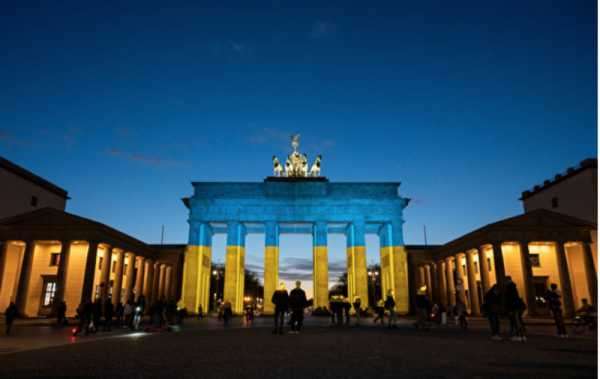
Berlin's Brandenburg Gate displaying the colours of the Ukraine flag earlier this week in solidarity (Photo: Berlin city government)
A brief recap on how we arrived today’s second Russian invasion of Ukraine, in what was already the longest conflict in Europe since the Second World War.
Following the illegal annexation of Crimea in the spring of 2014, armed militants emerged in eastern Ukraine. These individuals stated that they wanted autonomy from Ukraine. These armed insurgents swiftly took control of the government buildings in Donetsk and Luhansk, two major cities within Ukraine’s Donbas region, and they proclaimed their autonomy from Kyiv. It would later be revealed that these armed individuals were Russian proxy forces looking to destabilise Ukraine. The Russian Federation had, in reality, already invaded its neighbour.
That first Russian military incursion into Ukraine has resulted in the displacement of nearly two million Ukrainians and the deaths of over 14,000. While the West has attempted to intervene through various diplomatic formats, they have come to no avail. In other words, the Donbas conflict continues without an end.
With Russian president Vladimir Putin’s decision to declare the self-proclaimed Donetsk and Luhansk People’s Republics as independent states, and now his seemingly fully-fledged invasion, we are where we are.
According to the Biden and Zelensky administrations, the Russian invasion will lead to the deaths of tens of thousands of Ukrainian citizens — let alone the soldiers on both sides.
Unprepared for European catastrophe
The RAND Corporation estimates that an escalation in the conflict will lead to an additional three-five million refugees.
These migrants, as well as the current internally displaced persons, would make up roughly 17 percent of Ukraine’s current population.
In other words, the events of Russia’s second invasion will be catastrophic.
Fearing for their lives, these Ukrainians will seek refuge in western and central Europe. This would lead to the largest movement of individuals in Europe since the 2015 Syrian refugee crisis.
Based on the current developments, Europe does not appear to be prepared.
To date, the EU is still recovering from the coronavirus pandemic.
Nonetheless, the European continent must be prepared for this potential mass migration of Ukrainians. The EU could create programmes to help Ukrainian refugees assimilate.
These initiatives could help the Ukrainian migrants find homes and jobs. European states could also grant Ukrainians temporary residence permits as they welcome these refugees.
In exchange for this European hospitality, these Ukrainian migrants could help boost the European economy. Many European states have struggled to recover from the coronavirus pandemic. Introducing these Ukrainians into the workforce would help revamp their economies.
According to the United Nations Educational, Scientific, and Cultural Organization, Ukraine has one of the world’s highest literacy rates.
Ukrainians are also very well-educated.
Ukrainians would promote diversity in the European workforce. Their cultural differences, values, and practices could provide a unique and innovative perspective in the work environment as companies address complex issues.
Finally, Ukrainian engineers, computer scientists, and information technicians are highly regarded. In fact, according to the Global Gig-Economy Index and Global Services Location Index, Ukraine has one of the best information technology sectors in the world.
In other words, these Ukrainian specialists would be valuable assets to the European labor force, and they should be welcomed.
Overall, Putin’s decision to invade Ukraine will be catastrophic. It will lead to the deaths of thousands, and millions will flee the country.
Should a major refugee crisis occur, the EU must develop a plan to aid these migrants. Otherwise, if Europe does not have a contingency plan for these migrants, this will lead to greater instability and chaos on the European continent.
Source: euobserver.com



